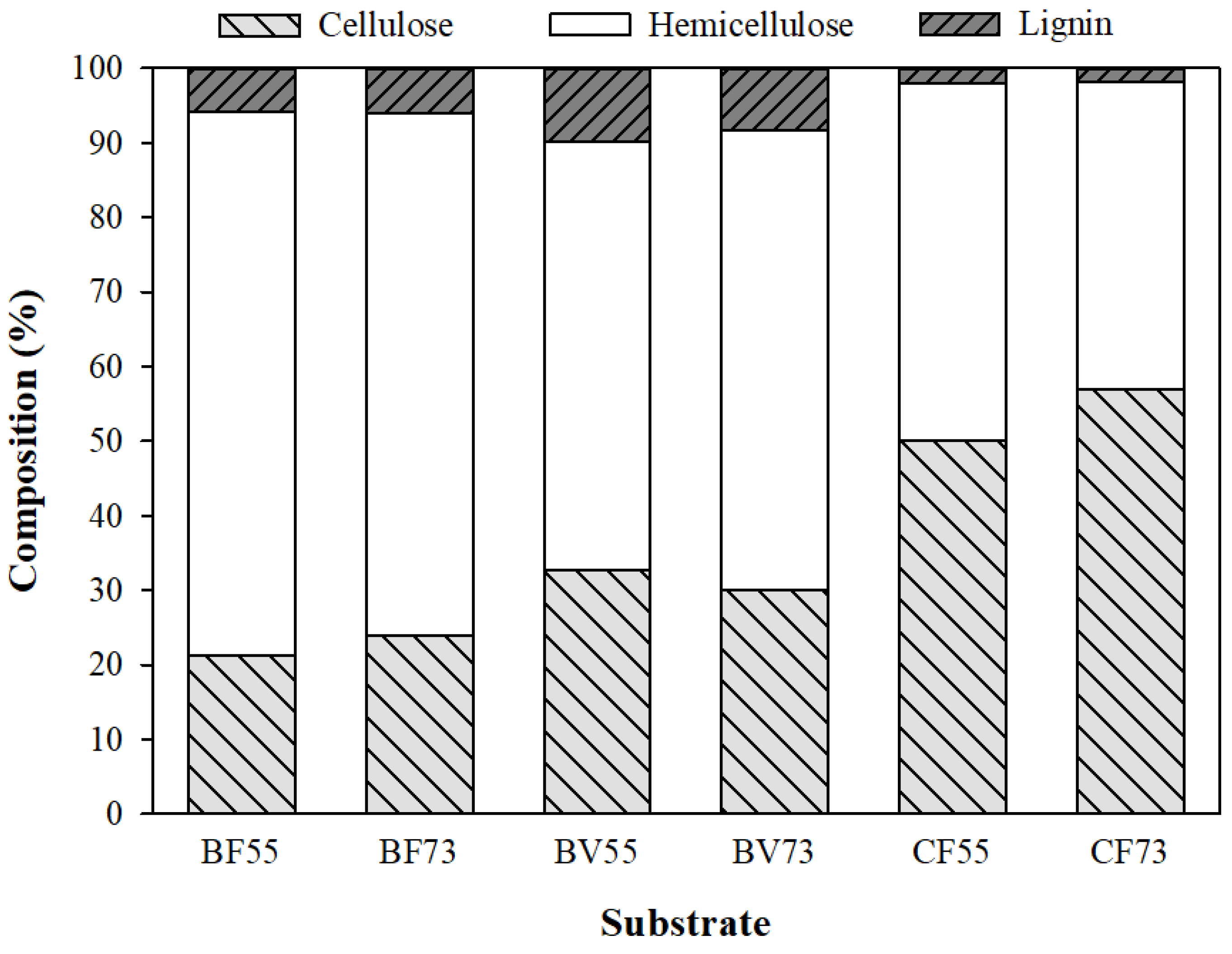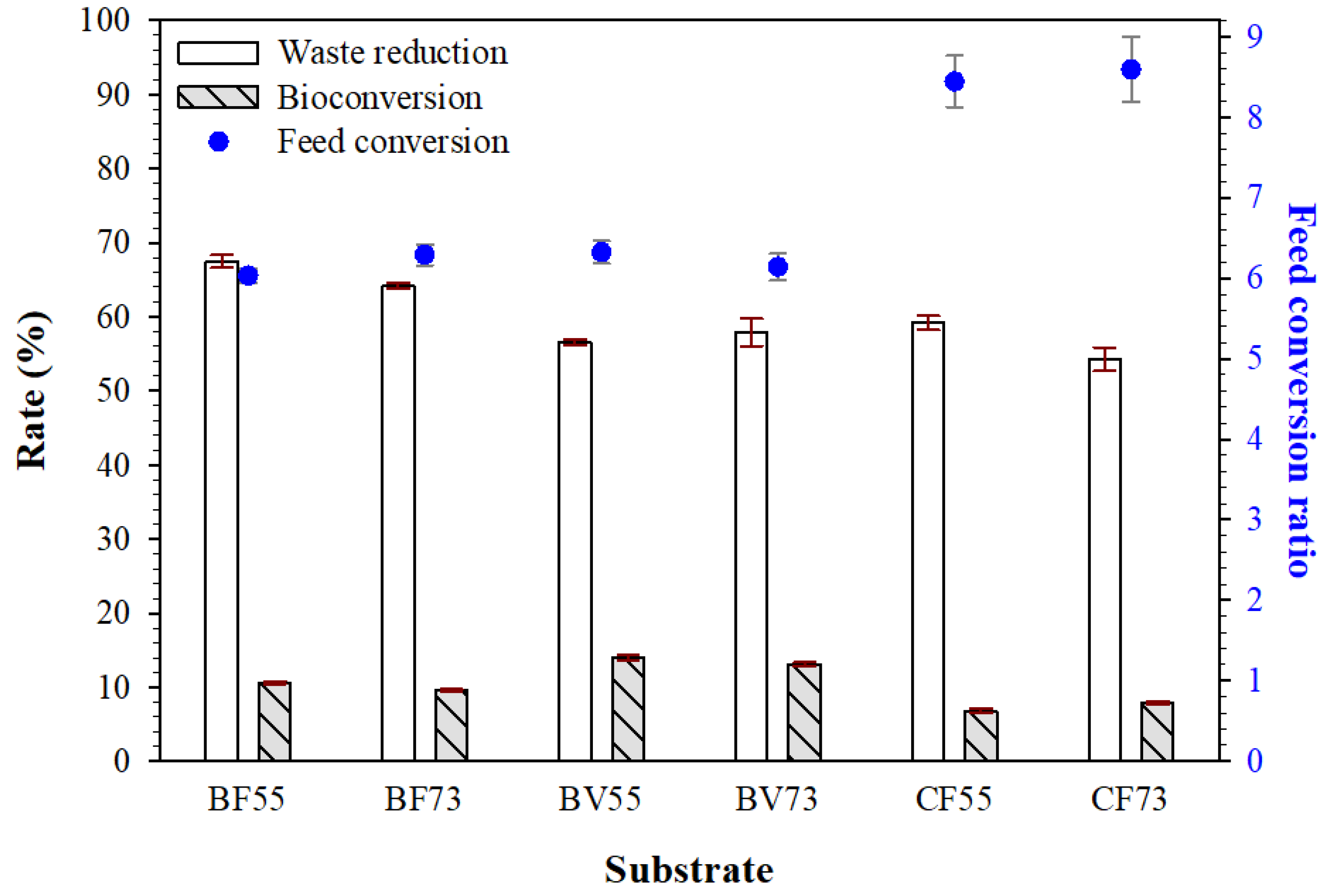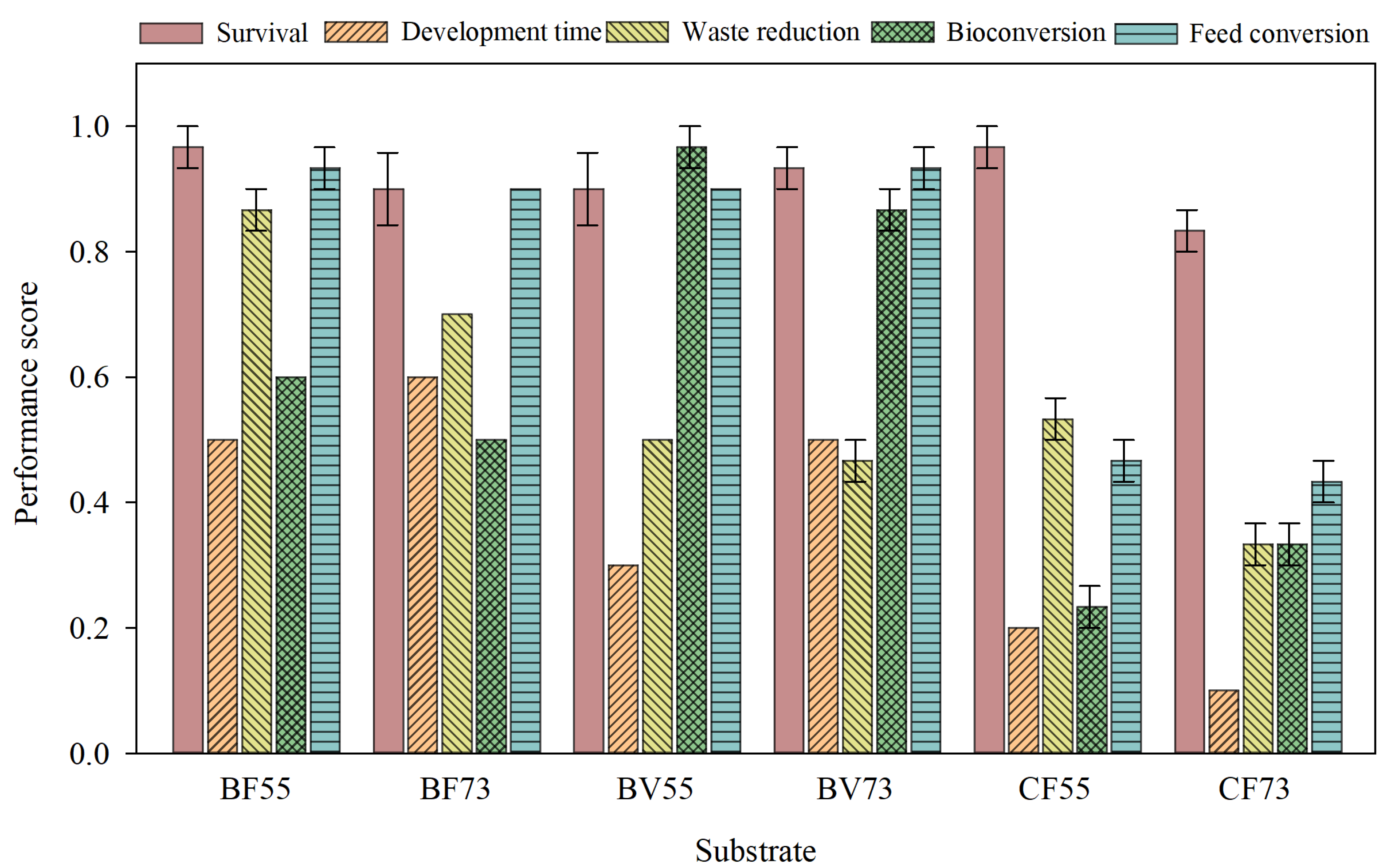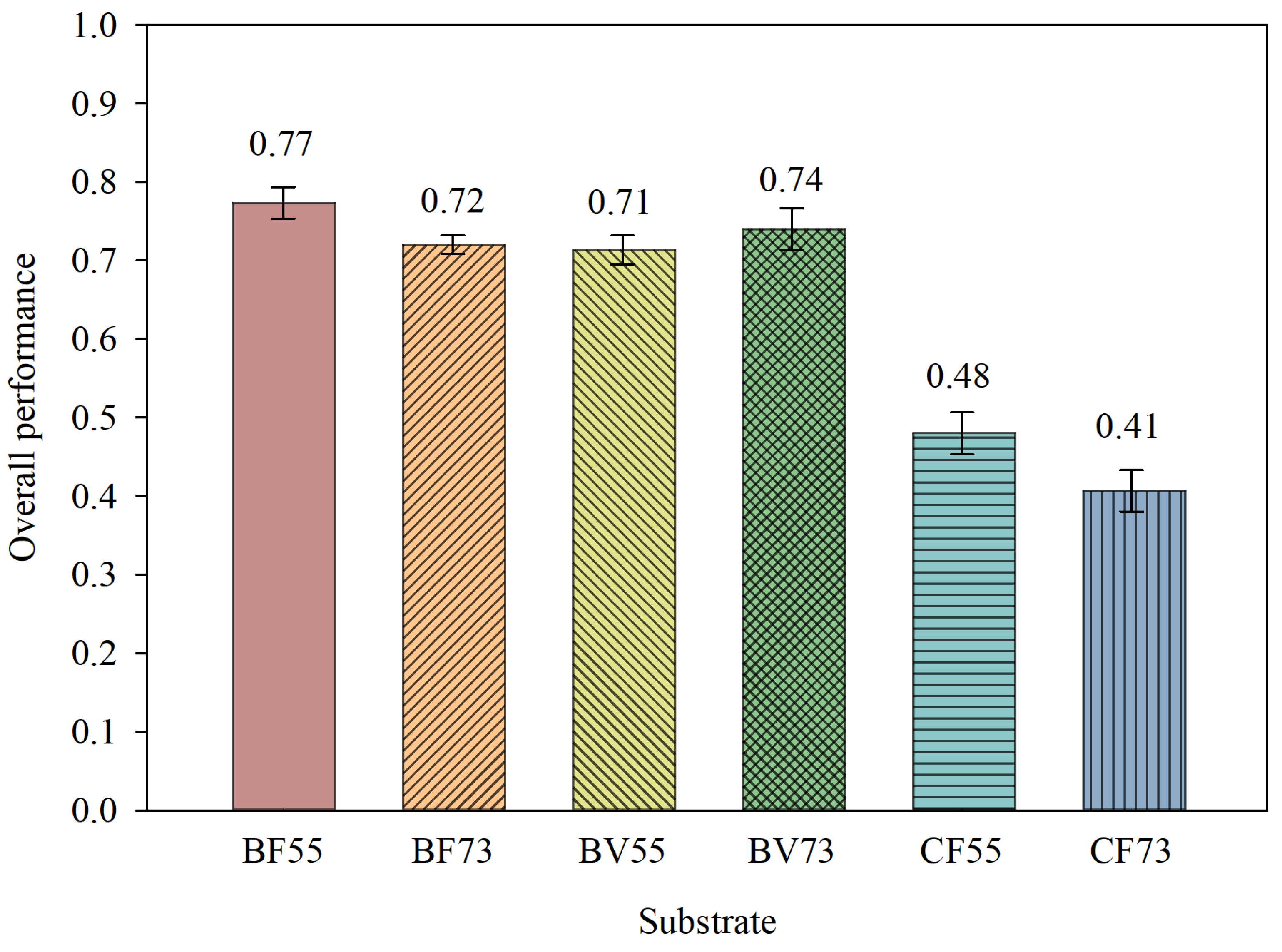Treatment of Agro-Industrial Residue and Organic Community Waste Using Black Soldier Fly Larvae: Overall Performance Assessment
Abstract
1. Introduction
2. Results and Discussion
2.1. Nutrient Composition of the Substrates
2.2. BSFL Rearing Performance Evaluation Using Five Performance Indicators
2.3. The Overall Performance of BSFL
3. Materials and Methods
3.1. Source of Agro-Industrial and Community Waste
3.2. Rearing Substrate Formulation
3.3. Chemical Analysis of Experimental Substrates
3.4. Source of Black Soldier Fly Larvae
3.5. Experimental Design and Setup
3.6. Analysis of BSFL Performance
3.7. Statistical Analysis
3.8. Assessment of the Overall Performance of BSFL Treatment
4. Conclusions
Author Contributions
Funding
Data Availability Statement
Acknowledgments
Conflicts of Interest
References
- FAO. The Future of Food and Agriculture—Trends and Challenges; FAO: Rome, Italy, 2017. [Google Scholar]
- Wilson, D.C.; Rodic, L.; Scheinberg, A.; Velis, C.A.; Alabaster, G. Comparative analysis of solid waste management in 20 cities. Waste Manag. Res. 2012, 30, 237–254. [Google Scholar] [CrossRef]
- Bortolini, S.; Macavei, L.I.; Saadoun, J.H.; Foca, G.; Ulrici, A.; Bernini, F.; Malferrari, D.; Setti, L.; Ronga, D.; Maistrello, L. Hermetia illucens (L.) larvae as chicken manure management tool for circular economy. J. Clean. Prod. 2020, 262, 121289. [Google Scholar] [CrossRef]
- Jucker, C.; Leonardi, M.G.; Rigamonti, I.; Lupi, D.; Savoldelli, S. Brewery’s waste streams as a valuable substrate for Black Soldier Fly Hermetia illucens (Diptera: Stratiomyidae). Entomology 2019, 51, 8876. [Google Scholar] [CrossRef]
- Taufek, N.M.; Zulkifli, N.F.N.M.; Hamizah, A.N. Upcycling of food waste generated from the fresh market by utilising black soldier fly larvae: Influence on growth, bioconversion, and nutritional composition. J. Environ. Manag. 2024, 349, 119467. [Google Scholar] [CrossRef]
- Papa, G.; Scaglia, B.; D’Imporzano, G.; Savoldelli, S.; Jucker, C.; Colombini, S.; Toschi, I.; Adani, F. Valorizing the organic fraction of municipal solid waste by producing black soldier fly larvae and biomethane in a biorefinery approach. J. Clean. Prod. 2022, 379, 134422. [Google Scholar] [CrossRef]
- Purkayastha, D.; Sarkar, S. Black soldier fly larvae for treatment and segregation of commingled municipal solid waste at different environmental condictions. J. Environ. Manag. 2022, 302, 114060. [Google Scholar] [CrossRef]
- Beesigamukama, D.; Mochoge, B.; Korir, N.K.; Fiaboe, K.K.; Nakimbugwe, D.; Khamis, F.M.; Subramanian, S.; Wangu, M.M.; Dubois, T.; Ekesi, S.; et al. Low-cost technology for recycling agro-industrial waste into nutrient-rich organic fertilizer using black soldier fly. Waste Manag. 2021, 119, 183–194. [Google Scholar] [CrossRef] [PubMed]
- Seyedalmoosavi, M.M.; Mielenz, M.; Veldkamp, T.; Daş, G.; Metges, C.C. Growth efficiency, intestinal biology, and nutrient utilization and requirements of black soldier fly (Hermetia illucens) larvae compared to monogastric livestock species: A review. J. Anim. Sci. Biotechnol. 2022, 13, 31. [Google Scholar] [CrossRef]
- Siddiqui, S.A.; Ristow, B.; Rahayu, T.; Putra, N.S.; Yuwono, N.W.; Mategeko, B.; Smetana, S.; Saki, M.; Nawaz, A.; Nagdalian, A. Black soldier fly larvae (BSFL) and their affinity for organic waste processing. Waste Manag. 2022, 140, 1–13. [Google Scholar] [CrossRef]
- Salam, M.; Shahzadi, A.; Zheng, H.; Alam, F.; Nabi, G.; Dezhi, S.; Ullah, W.; Ammara, S.; Ali, N.; Bilal, M. Effect of different environmental conditions on the growth and development of Black Soldier Fly Larvae and its utilization in solid waste management and pollution mitigation. Environ. Technol. Innov. 2022, 28, 102649. [Google Scholar] [CrossRef]
- Ebeneezar, S.; Tejpal, C.; Jeena, N.; Summaya, R.; Chandrasekar, S.; Sayooj, P.; Vijayagopal, P. Nutritional evaluation, bioconversion performance and phylogenetic assessment of black soldier fly (Hermetia illucens, Linn. 1758) larvae valorized from food waste. Environ. Technol. Innov. 2021, 23, 101783. [Google Scholar] [CrossRef]
- Gao, Z.; Wang, W.; Lu, X.; Zhu, F.; Liu, W.; Wang, X.; Lei, C. Bioconversion performance and life table of black soldier fly (Hermetia illucens) on fermented maize straw. J. Clean. Prod. 2019, 230, 974–980. [Google Scholar] [CrossRef]
- Isibika, A.; Vinneras, B.; Kibazohi, O.; Zurbriigg, C.; Lalander, C. Pre-treatment of banana peel to improve composting by black soldier fly (Hermetia illucens (L.) Diptera: Stratiomyidae) larvae. Waste Manag. 2019, 100, 151–160. [Google Scholar] [CrossRef] [PubMed]
- Nawirska-Olszańska, A.; Biesiada, A.; Sokół-Łętowska, A.; Kucharska, A.Z. Characteristics of organic acids in the fruit of different pumpkin species. Food Chem. 2014, 148, 415–419. [Google Scholar] [CrossRef] [PubMed]
- Cheng, J.Y.K.; Chiu, S.L.H.; Lo, I.M.C. Effects of moisture content of food waste on residue separation, larval growth and larval survival in black soldier fly bioconversion. Waste Manag. 2017, 67, 315–323. [Google Scholar] [CrossRef]
- Amrul, N.F.; Kabir Ahmad, I.; Ahmad Basri, N.E.; Suja, F.; Abdul Jalil, N.A.; Azman, N.A. A review of organic waste treatment using black soldier fly (Hermetia illucens). Sustainability 2022, 14, 4565. [Google Scholar] [CrossRef]
- Yakti, W.; Müller, M.; Klost, M.; Mewis, I.; Dannehl, D.; Ulrichs, C. Physical properties of substrates as a driver for Hermetia illucens (L.)(Diptera: Stratiomyidae) larvae growth. Insects 2023, 14, 266. [Google Scholar] [CrossRef] [PubMed]
- Xiang, F.; Zhang, Q.; Xu, X.; Zhang, Z. Black soldier fly larvae recruit functional microbiota into the intestines and residues to promote lignocellulosic degradation in domestic biodegradable waste. Environ. Pollut. 2024, 340, 122676. [Google Scholar] [CrossRef]
- Hosseindoust, A.; Ha, S.H.; Mun, J.Y.; Kim, J.S. Quality characteristics of black soldier flies produced by different substrates. Insects 2023, 14, 500. [Google Scholar] [CrossRef]
- Peguero, D.A.; Gold, M.; Vandeweyer, D.; Zurbrügg, C.; Mathys, A. A review of pretreatment methods to improve agri-food waste bioconversion by black soldier fly larvae. Front. Sustain. Food Syst. 2022, 5, 745894. [Google Scholar] [CrossRef]
- English, G.; Wanger, G.; Colombo, S.M. A review of advancements in black soldier fly (Hermetia illucens) production for dietary inclusion in salmonid feeds. J. Agric. Food Res. 2021, 5, 100164. [Google Scholar] [CrossRef]
- Lim, J.-W.; Mohd-Noor, S.-N.; Wong, C.-Y.; Lam, M.-K.; Goh, P.-S.; Beniers, J.; Oh, W.-D.; Jumbri, K.; Ghani, N.A. Palatability of black soldier fly larvae in valorizing mixed waste coconut endosperm and soybean curd residue into larval lipid and protein sources. J. Environ. Manag. 2019, 231, 129–136. [Google Scholar] [CrossRef]
- Frooninckx, L.; Broeckx, L.; Goossens, S.; Wuyts, A.; Van Miert, S. Optimizing substrate moisture content for enhanced larval survival and growth performance in Hermetia illucens: Exploring novel approaches. Discov. Anim. 2024, 1, 7. [Google Scholar] [CrossRef]
- Meneguz, M.; Schiavone, A.; Gai, F.; Dama, A.; Lussiana, C.; Renna, M.; Gasco, L. Effect of rearing substrate on growth performance, waste reduction efficiency and chemical composition of black soldier fly (Hermetia illucens) larvae. J. Sci. Food Agric. 2018, 18, 5776–5784. [Google Scholar] [CrossRef] [PubMed]
- Yakti, W.; Schulz, S.; Marten, V.; Mewis, I.; Padmanabha, M.; Hempel, A.-J.; Kobelski, A.; Streif, S.; Ulrichs, C. The effect of rearing scale and density on the growth and nutrient composition of Hermetia illucens (L.)(Diptera: Stratiomyidae) larvae. Sustainability 2022, 14, 1772. [Google Scholar] [CrossRef]
- Lomonaco, G.; Franco, A.; De Smet, J.; Scieuzo, C.; Salvia, R.; Falabella, P. Larval frass of Hermetia illucens as organic fertilizer: Composition and beneficial effects on different crops. Insects 2024, 15, 293. [Google Scholar] [CrossRef]
- Suttibak, S.; Sukthanapirat, R.; Chansakhatana, N.; Photharin, S.; Sriyoha, R. Black soldier fly rearing technique for organic waste treatment. In Proceedings of the 10th International Conference on Environmental Engineering, Science and Management, Khon Kaen, Thailand, 12–14 May 2021. [Google Scholar]
- Pliantiangtam, N.; Chundang, P.; Kovitvaaaadhi, A. Growth performance, waste reduction efficiency and nutritional composition of black soldier fly (Hermetia illucens) larvae and prepupae reared on coconut endosperm and soybean curd residue with or without supplementation. Insects 2021, 12, 682. [Google Scholar] [CrossRef]
- Bewick, V.; Cheek, L.; Ball, J. Statistics review 9: One-way analysis of variance. Crit. Care 2004, 8, 130. [Google Scholar] [CrossRef]
- Phaengphairee, P.; Boontiam, W.; Wealleans, A.; Hong, J.; Kim, Y.Y. Dietary supplementation with full-fat Hermetia illucens larvae and multi-probiotics, as a substitute for antibiotics, improves the growth performance, gut health, and antioxidative capacity of weaned pigs. BMC Vet. Res. 2023, 19, 7. [Google Scholar] [CrossRef]
- Bohm, K.; Hatley, G.A.; Robinson, B.H.; Gutierrez, M.J. Black Soldier Fly-based bioconversion of biosolid high-value product with low heavy metal concentration. Resour. Conserv. Recycl. 2022, 180, 106149. [Google Scholar] [CrossRef]
- Chia, S.Y.; Tanga, C.M.; Osuga, I.M.; Mohamed, S.A.; Khamis, F.M.; Salifu, D.; Sevgan, S.; Fiaboe, K.K.; Niassy, S.; van Loon, J.J. Effects of waste stream combinations from brewing industry on performance of Black Soldier Fly, Hermetia illucens (Diptera: Stratiomyidae). PeerJ 2018, 6, e5885. [Google Scholar] [CrossRef] [PubMed]
- Diener, S.; Solano, N.M.S.; Gutierrez, F.R.; Zurbrugg, C.; Tockner, K. Biological treatment of municipal organic waste using black soldier fly larvae. Waste Biomass Valorization 2011, 2, 357–363. [Google Scholar] [CrossRef]
- Gold, M.; Cassar, C.M.; Zurbrugg, C.; Kreuzer, M.; Boulos, S.; Diener, S.; Mathys, A. Biowaste treatment with black soldier fly larvae: Increase performance through the formulation of biowaste based on protein and carbohydrates. Waste Manag. 2020, 102, 319–329. [Google Scholar] [CrossRef] [PubMed]
- Lalander, C.; Diener, S.; Zurbriigg, C.; Vinneras, B. Effects of feedstock on larval development and process efficiency in waste treatment with black soldier fly (Hermetia illucens). J. Clean. Prod. 2019, 208, 211–219. [Google Scholar] [CrossRef]
- Liu, Z.; Minor, M.; Morel, P.C.H.; Najar-Rodriguez, A.J. Bioconversion of three organic wastes by Black Soldier Fly (Diptera: Stratiomyidae) Larvae. Environ. Entomol. 2018, 47, 1609–1617. [Google Scholar] [CrossRef]
- Quan, N.H.; Tam, V.T.M.; Thao, L.D.; Ngoan, L.D. Effect of inclusion of black soldier fly larvae (Hermetia illucens) meal in diets on growth performance and meat quality of growing quail. Livest. Res. Rural. Dev. 2023, 35, 23. [Google Scholar]
- Rehman, K.u.; Rehman, A.; Cai, M.; Zheng, L.; Xiao, X.; Somroo, A.A.; Wang, H.; Yu, Z.; Zhang, J. Conversion of mixtures of dairy manure and soybean curd residue by black soldier fly larvae (Hermetia illucen L.). J. Clean. Prod. 2017, 154, 366–373. [Google Scholar] [CrossRef]
- Sideris, V.; Georgiadou, M.; Papadoulis, G.; Mountzouris, K. Effect processed beverage by-product-based diets on biological parameters, conversion efficiency and body composition of Hermetia illucens (L) (Diptera: Stratiomyidae). Insects 2021, 12, 475. [Google Scholar] [CrossRef]
- Greene, K.L.; Tonjes, D.J. Quantitative assessments of municipal waste management systems: Using different indicators to compare and rank programs in New York State. Waste Manag. 2014, 34, 825–836. [Google Scholar] [CrossRef]




| Parameter | BF55 | BF73 | BV55 | BV73 | CF55 | CF73 |
|---|---|---|---|---|---|---|
| pH | 4.97 ± 0.14 b | 4.66 ± 0.11 a | 4.84 ± 0.13 ab | 4.76 ± 0.09 ab | 5.69 ± 0.11 c | 5.85 ± 0.14 c |
| Moisture content (%) | 79.28 ± 0.86 b | 80.16 ± 0.52 b | 83.88 ± 0.68 d | 81.90 ± 0.73 c | 75.82 ± 0.38 a | 76.72 ± 0.76 a |
| Volatile solid (%) db | 88.22 ± 0.70 c | 89.46 ± 0.78 d | 87.08 ± 0.79 c | 90.01 ± 0.60 d | 75.34 ± 0.18 b | 72.73 ± 0.68 a |
| Total organic carbon (%) | 46.41 ± 0.16 c | 47.72 ± 0.05 d | 50.54 ± 0.32 f | 50.19 ± 0.03 e | 38.28 ± 0.18 b | 36.33 ± 0.15 a |
| Total nitrogen (%) | 3.79 ± 0.02 d | 4.33 ± 0.02 e | 3.65 ± 0.09 c | 4.25 ± 0.05 e | 2.31 ± 0.04 b | 2.20 ± 0.06 a |
| Crude protein (%) | 23.69 ± 0.14 d | 27.04 ± 0.14 e | 22.78 ± 0.57 c | 26.56 ± 0.32 e | 14.44± 0.25 b | 13.74 ± 0.38 a |
| C/N ratio | 12.25 ± 0.10 b | 11.03 ± 0.19 a | 13.87 ± 0.12 c | 11.84 ± 0.30 b | 16.86 ± 0.76 d | 16.53 ± 0.36 d |
| Cellulose (%) | 7.99 ± 0.08 a | 10.68 ± 0.08 b | 14.63 ± 0.27 c | 14.66 ± 0.15 c | 21.20 ± 0.15 d | 29.18 ± 0.27 e |
| Hemicellulose (%) | 27.47 ± 0.21 d | 31.27 ± 0.19 f | 25.62 ± 0.43 c | 30.16 ± 0.28 e | 20.26 ± 0.24 a | 21.17 ± 0.17 b |
| Lignin (%) | 2.16 ± 0.01 b | 2.69 ± 0.05 c | 4.41 ± 0.04 e | 4.04 ± 0.01 d | 0.89 ± 0.02 a | 0.91 ± 0.01 a |
| Substrate | Survival Rate (%) | Development Time * (Days) | Waste Reduction Rate (%) | Bioconversion Rate (%) | Feed Conversion Ratio |
|---|---|---|---|---|---|
| BF55 | 99.42 ± 0.58 a | 18.83 | 67.52 ± 0.87 c | 10.62 ± 0.20 d | 6.03 ± 0.09 a |
| BF73 | 98.33 ± 0.82 a | 18.12 | 64.17 ± 0.34 c | 9.57 ± 0.16 c | 6.29 ± 0.13 a |
| BV55 | 98.75 ± 0.92 a | 19.17 | 56.58 ± 0.39 ab | 14.03 ± 0.39 f | 6.32 ± 0.14 a |
| BV73 | 99.00 ± 0.59 a | 18.25 | 57.90 ± 1.85 b | 13.12 ± 0.21 e | 6.14 ± 0.17 a |
| CF55 | 99.08 ± 0.62 a | 20.21 | 59.18 ± 0.97 b | 6.78 ± 0.26 a | 8.44 ± 0.32 b |
| CF73 | 97.83 ± 0.48 a | 20.75 | 54.30 ± 1.57 a | 7.89 ± 0.17 b | 8.59 ± 0.40 b |
| ANOVA p-value | 0.642 | N/A | 0.000 | 0.000 | 0.000 |
| Rearing Substrate | Composition (% Wet Basis) | |||
|---|---|---|---|---|
| Brewery Waste | Filter Cake | Vegetable and Fruit Waste | Food Waste | |
| BF55 | 50 | - | - | 50 |
| BF73 | 70 | - | - | 30 |
| BV55 | 50 | - | 50 | - |
| BV73 | 70 | - | 30 | - |
| CF55 | - | 50 | - | 50 |
| CF73 | - | 70 | - | 30 |
| Indicator | Reported Values | Rearing Substrates | References |
|---|---|---|---|
| Survival rate (%) | 92.00–99.33 | Brewery waste, canteen waste, soybean curd residual, food waste, municipal organic waste, vegetable and fruit waste, dairy manure, and commingled MSW | [7,32,33,34,35,36,37,38,39,40] |
| Development time (days) | 14.97–20.20 | ||
| Waste reduction rate (%) | 55.30–72.40 | ||
| Bioconversion rate (%) | 3.80–13.33 | ||
| Feed conversion ratio | 3.82–10.10 |
| Indicator | Assessment criteria |
|---|---|
| Survival rate (%) | 0.0 = below 90.00% 0.1 = between 90.01 and 91.00% 0.2 = between 91.01 and 92.00% 0.3 = between 92.01 and 93.00% 0.4 = between 93.01 and 94.00% 0.5 = between 94.01 and 95.00% 0.6 = between 95.01 and 96.00% 0.7 = between 96.01 and 97.00% 0.8 = between 97.01 and 98.00% 0.9 = between 98.01 and 99.00% 1.0 = greater than 99.01% |
| Development time (day) | 0.0 = greater than 21.00 days 0.1 = between 20.51 and 21.00 days 0.2 = between 20.01 and 20.50 days 0.3 = between 19.51 and 20.00 days 0.4 = between 19.01 and 19.50 days 0.5 = between 18.51 and 19.00 days 0.6 = between 18.01 and 18.50 days 0.7 = between 17.51 and 18.00 days 0.8 = between 17.01 and 17.50 days 0.9 = between 16.51 and 17.00 days 1.0 = shorter than 16.50 days |
| Waste reduction rate (%) | 0.0 = below 47.51% 0.1 = between 47.51 and 50.00% 0.2 = between 50.01 and 52.50% 0.3 = between 52.51 and 55.00% 0.4 = between 55.01 and 57.50% 0.5 = between 57.51 and 60.00% 0.6 = between 60.01 and 62.50% 0.7 = between 62.51 and 65.00% 0.8 = between 65.01 and 67.50% 0.9 = between 67.51 and 70.00% 1.0 = greater than 70.00% |
| Bioconversion rate (%) | 0.0 = below 5.01% 0.1 = between 5.01 and 6.00% 0.2 = between 6.01 and 7.00% 0.3 = between 7.01 and 8.00% 0.4 = between 8.01 and 9.00% 0.5 = between 9.01 and 10.00% 0.6 = between 10.01 and 11.00% 0.7 = between 11.01 and 12.00% 0.8 = between 12.01 and 13.00% 0.9 = between 13.01 and 14.00% 1.0 = greater than 14.0% |
| Feed conversion ratio | 0.0 = greater than 10.50 0.1 = between 10.01 and 10.50 0.2 = between 9.51 and 10.00 0.3 = between 9.01 and 9.50 0.4 = between 8.51 and 9.00 0.5 = between 8.01 and 8.50 0.6 = between 7.51 and 8.00 0.7 = between 7.01 and 7.50 0.8 = between 6.51 and 7.00 0.9 = between 6.01 and 6.50 1.0 = less than 6.01 |
Disclaimer/Publisher’s Note: The statements, opinions and data contained in all publications are solely those of the individual author(s) and contributor(s) and not of MDPI and/or the editor(s). MDPI and/or the editor(s) disclaim responsibility for any injury to people or property resulting from any ideas, methods, instructions or products referred to in the content. |
© 2025 by the authors. Licensee MDPI, Basel, Switzerland. This article is an open access article distributed under the terms and conditions of the Creative Commons Attribution (CC BY) license (https://creativecommons.org/licenses/by/4.0/).
Share and Cite
Sukthanapirat, R.; Chansakhatana, N.; Baotong, S.; Pukdee, W.; Lokaewmanee, K.; Sriyoha, R.; Kanchanatip, E.; Suttibak, S. Treatment of Agro-Industrial Residue and Organic Community Waste Using Black Soldier Fly Larvae: Overall Performance Assessment. Recycling 2025, 10, 186. https://doi.org/10.3390/recycling10050186
Sukthanapirat R, Chansakhatana N, Baotong S, Pukdee W, Lokaewmanee K, Sriyoha R, Kanchanatip E, Suttibak S. Treatment of Agro-Industrial Residue and Organic Community Waste Using Black Soldier Fly Larvae: Overall Performance Assessment. Recycling. 2025; 10(5):186. https://doi.org/10.3390/recycling10050186
Chicago/Turabian StyleSukthanapirat, Rathanit, Natpapat Chansakhatana, Somchai Baotong, Wannapa Pukdee, Kanda Lokaewmanee, Ramin Sriyoha, Ekkachai Kanchanatip, and Samonporn Suttibak. 2025. "Treatment of Agro-Industrial Residue and Organic Community Waste Using Black Soldier Fly Larvae: Overall Performance Assessment" Recycling 10, no. 5: 186. https://doi.org/10.3390/recycling10050186
APA StyleSukthanapirat, R., Chansakhatana, N., Baotong, S., Pukdee, W., Lokaewmanee, K., Sriyoha, R., Kanchanatip, E., & Suttibak, S. (2025). Treatment of Agro-Industrial Residue and Organic Community Waste Using Black Soldier Fly Larvae: Overall Performance Assessment. Recycling, 10(5), 186. https://doi.org/10.3390/recycling10050186






